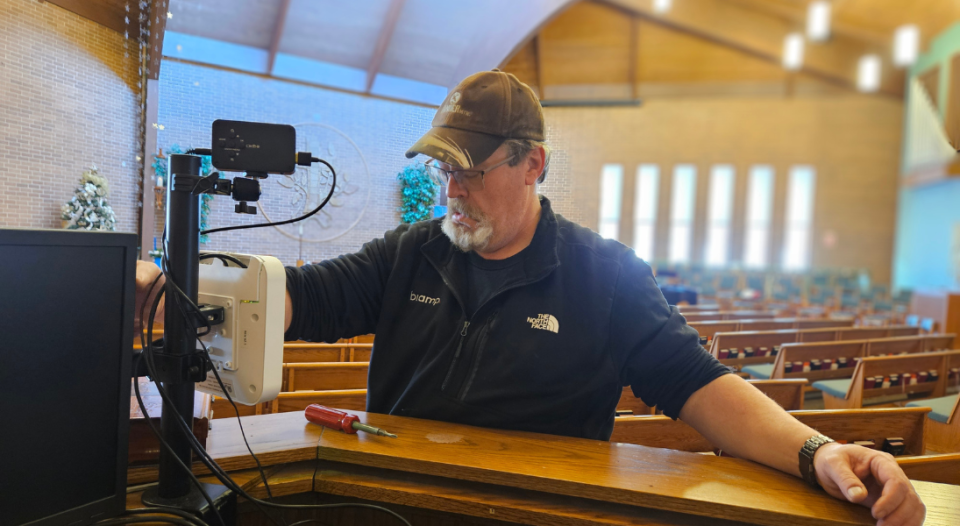More than 50 million Americans currently experience some form of hearing loss (including more than 10% of children and teens and a whopping 65% of people over 70), according to the Hearing Loss Association of America. It is the most prevalent disability impacting meaningful worship. Yet it is easier than ever to accommodate by offering what is commonly called an assistive listening system.
At Grace Lutheran Church in Woodstock, Ill., we have been using a new, cost-effective technology called Auracast since the beginning of the year, with excellent results.
Struggling to hear, to worship
Studies show that when people can’t hear well, fatigue increases and the ability to recall what was said is reduced. Some people even withdraw from those situations altogether.
Many of our sanctuaries are reverberant (having a slight echo) either by design or by chance. At Grace, the reverberance of the sanctuary makes the organ come alive. However, what’s good for music isn’t good for the spoken word. Voices, especially higher-pitched ones, can become harder to comprehend without straining. Hence our need for assistive listening despite having a good sound system.
The problem is often worse for congregations that worship in nontraditional spaces such as meeting rooms and school gyms. Even people without hearing loss can have a hard time listening without difficulty in these environments. Who hasn’t been to a meeting, conference or worship service where it was a struggle to just relax and let the message sink in?
Choices, choices
The way to provide easily understandable sound for everyone is to broadcast audio directly to people’s ears. This is what an assistive listening system does. At Grace, we had one based on a proprietary FM radio link, but it was aging, with static and interference periodically causing problems. New systems were becoming available, so it was time to revisit what was best. We wanted a system that wouldn’t break the bank, could be used discreetly by as many people as possible, including those without hearing aids, and provided consistently good sound.
The oldest and most traditional assistive listening system is called a hearing loop, a cable under the carpet or floor that encircles each seating section and is connected to the sound system. Its primary benefit is that for many years, hearing aids with a telecoil (or T-coil) inside could pick up the signal directly. But everyone else has to use a handheld receiver with an earpiece. The system is also expensive to install, especially in existing buildings with an intact floor.
We wanted an affordable system that more people could conveniently use. The latter is important. Since only about 20% of people with hearing loss use hearing aids, we needed a different approach to help more of our members hear well and be able to immerse themselves in worship.
Since only about 20% of people with hearing loss use hearing aids, we needed a different approach.
Earlier we might have just updated our FM system or chosen a similar one using infrared light or Wi-Fi to transmit the audio. These are affordable, but they require everyone to use handheld devices, sometimes worn around the neck. Not everyone wants to do that, which limits the number of people who would use the system. They can also have other problems that include interference and delay.
Auracast is a new version of Bluetooth that many people can tune in to at the same time, just like selecting a radio channel. It isn’t owned by any one company; any Bluetooth device manufacturer can be part of it. More and more are.
A big attraction is that people can use their own compatible device to tune in, whether it be a consumer earbud or a hearing aid. We still bought some handheld receivers with discreet earpieces and personal neckloops (for wearers of hearing aids with telecoils) that worshipers can use today. Over time, more people will “bring their own,” reducing the need for handheld receivers. Today one major hearing aid brand has models that work with Auracast, and the others will soon. They all participated in the system’s development.
Consumer companies are getting on board because Auracast is also designed to broadcast the audio in theaters, in music venues and from silent TVs in restaurants and gyms, plus in airports, train stations and the like. Just as people purchase Auracast-compatible earbuds to hear TV in a gym, they can bring them to worship too.
Grace’s installation experience
The transmitter we chose is a small unit about the size of a Wi-Fi hub, called Auri. At the time, it was the only one available that also offered handheld receivers (now there are at least three others). It’s not difficult to install, but it helps to have someone familiar with the congregation’s sound system, as we did. For those who must pack up their system after worship, the transmitter can be mounted on a portable tripod.
The reception at Grace has been overwhelmingly positive, and the system is used more than our FM radio link. Our goal is to serve everyone who could benefit from listening assistance. By enabling people to hear better, we are fulfilling the call to welcome more people into fuller participation in the life of our church.






